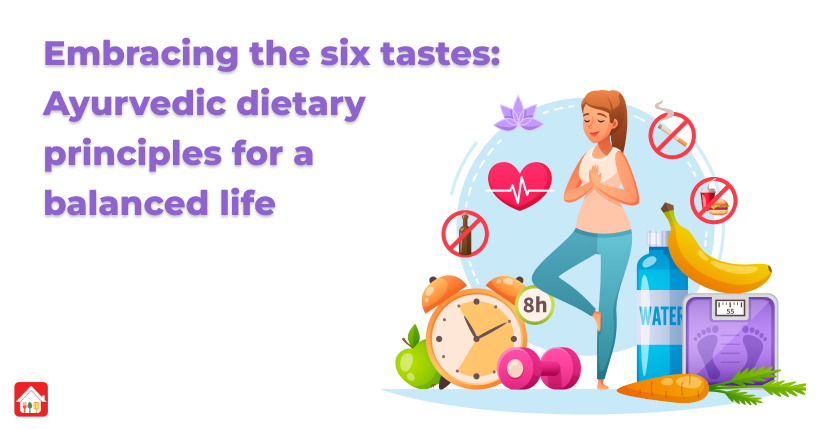Table of Contents
Ayurveda, like Yoga, is all about creating balance. You will be healthy when the mind and body are in harmony and balance. Ayurveda, the study of life, gives you the tools and knowledge to create and understand this union or balance.
How you eat is essential for creating balance in your daily life, as it affects your health, emotions, and mental state. Caffeine can cause a spike followed by a crash with jitters. Chocolate can make you feel suitable for a short time, but it can also leave you feeling regretful and lethargic. Spicy food may give you an immediate rush, but it can also decimate your taste buds over time and make you crave highly flavored food all the time. Strong tastes can create an acidic environment in the cells, ideal for chronic diseases.
Any substance that changes our brain chemistry and alters our emotional state can be addictive. Food that is balanced, or sattvic, leaves you feeling clean, alert, and bright. It is even true if, in your heart, you are practicing Ahimsa or non-violence by choosing organic, fair-trade, and vegan foods.
The 6 Tastes of Ayurveda
Sweet Taste

The sweet taste is soothing and nourishing. Sweet flavors are associated with happiness, love, comfort, greed, and attachment. We need it, but too much, or the wrong kind of sugar, can increase Kapha, making you want to hunt down cookies and ice cream. Overindulging in these foods long-term can lead to various health issues. In Ayurvedic, sweet does not refer to sugars processed. It is the naturally occurring sweetness of foods. Moderation is considered essential for good health.
Sour taste (Lavana)
Water and fire that make up a sour taste increase pitta, kapha, and vata dosha. Fermented foods, yogurt, sour vegetables and fruits, and sour fruit and vegetables increase saliva and appetite. This taste improves digestion and awakens emotions. Lemon, vinegar, pickled veggies, raw mango, and tamarind are the best sources of sour flavor.
Salty

This taste is composed of earth and flame. Salty flavors can help reduce vata while increasing Kapha and Pitta.” Salty tastes are hydrating and help in digestion. Sea salt, rock salt, seafood, seaweed, and leafy greens are the best sources of salty flavor. According to Ayurveda, excessive salt consumption can increase blood pressure and adversely affect the skin and blood.
Pungent Taste

Spicy food has a pungent flavor that is hot and peppery. It aggravates pitta and vata in excess but balances the cold Kapha. It is a great way to stimulate appetite and clear sinuses. However, quantity can adversely affect the nervous and digestive systems and cause anger, violence, and aggression.
Bitter Taste

Bitter foods benefit pitta dosha and Kapha. Bitter foods are detoxifying by nature and can help to remove toxic materials from the body. To detoxify your body, it is recommended that you eat bitter gourds, neem/Indian Lilac, coffee, and chocolate, as well as fenugreek and other spices.
Astringent Taste

It is cleansing, astringent and creates a feeling of dryness in the mouth. It is used in moderation to help focus the mind. In excess, it can cause disorganization, anxiety, and depression. It balances both pitta (the negative) and kapha (the positive) but can aggravate vata when taken to excess.
How to balance taste in Ayurvedic food?
Ayurveda stresses the importance of eating whole, fresh foods in season, locally grown. They are considered the best for our bodies, as they contain the highest prana levels (subtle energy of life) and give us sattvic energy (pure and balanced). Ayurveda also suggests eating a balanced and complete diet, which includes all six tastes mentioned by ancient science. These are sweet, sour, and salty.
You should also consider your body type or constitution, known as doshas – vata pitta kapha. Each dosha is different in its dietary needs and recommendations. Vata-types may be better off with warming, grounding food, while pitta-types may be better off with cooling foods.
Ayurveda stresses the importance of understanding the body’s needs by its qualities. To maintain good physical and mental health, we should eat until 80% complete. We also need to include the six tastes. Understanding your body type and including appropriate foods to compensate for certain qualities or gunas in your diet can also help balance your doshas.
Selecting foods according to your dosha
Ayurveda helps each achieve their ideal state of health by identifying and maintaining their Prakruti.
Vata
Vatas are often more anxious and spacey. Vatas tend to speak fast and have joints that crack. Vata affects the flow of feelings, thoughts, prana, nerve impulses, and bodily fluids.
Pitta
Pittas are fierier than any other type. They have a better appetite and digestion. As they have a hotter head, they can better withstand cold temperatures. They are intelligent and sharp but also naturally impatient and aggressive. Pittas can eat almost anything because they have strong digestion. Pittas are usually in trouble when they overeat, use too much salt or sour, spicy or sour food, or overeat.
Kapha
Kaphas are heavier and earthier than other types. They also tend to store fluids, fats, and fluids more readily. A Kapha is naturally calm, attached, and melodic. Sometimes they have wet dreams, and their elimination is usually thick and heavy.
Tips on how to incorporate the six tastes in your daily meals
You can recognize the six tastes as follows: sweet, sour, salty, pungent, bitter astringent.
Foods like grains, fruits, and dairy products have a sweet taste. It is said to nourish the body and calm the mind. Citrus fruits, yogurt, and fermented food have a sour taste. It is thought to increase appetite and stimulate digestion.
You can find salty foods in many different types of food, including seafood, soy sauce, and, yes, even in the world itself. It’s believed to increase taste, thirst, and digestion. Foods like garlic, ginger, and chili peppers have a pungent taste. It’s supposed to clear congestion and stimulate digestion.
Foods like bitter gourd, turmeric, and leafy greens taste bitter. It is said to improve digestion and detoxify the body. Beans, lentils, and certain fruits have an astringent flavor. It is thought to tighten and tone tissue and dry out excess moisture.
Conclusion
Like most Ayurvedic practices, the right combination of flavors for you is primarily determined by you: your constitution, your imbalances, your age, and your environment.
Connect with the taste of food. Discover the dominant taste of each meal. What do you want? What helps you to feel calm, centered, and nourished when you eat?
Ayurveda says that when used in the correct dose and collectively or individually, each taste balances the body’s systems. This leads to happiness and health for all living creatures!


